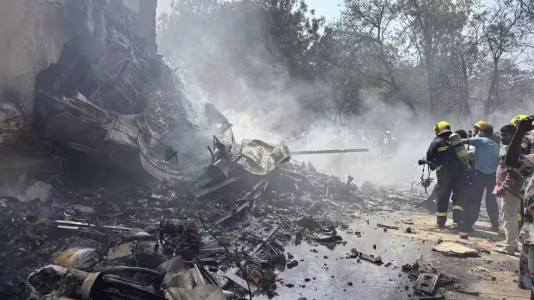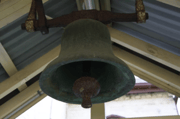‘I stood up and ran’: He walked away from the wreckage of the Air India crash no one else survived
By
Maan
- Replies 2
Content Warning: This article contains graphic content that may be distressing to some readers. Discretion is advised.
Air travel is often seen as one of the safest forms of transport—but when disaster strikes, the impact is devastating.
A recent international flight has turned into the worst aviation tragedy in years, sparking urgent investigations and global concern.
Here’s what we know so far about a catastrophic event that left authorities reeling and families grieving.
What began as a routine international departure ended in one of the deadliest aviation tragedies in a decade.
An Air India flight en route to London crashed shortly after take-off from Ahmedabad, leaving behind devastation, disbelief, and a death toll that stunned authorities across the globe.
But among the wreckage, one man emerged alive—clutching his boarding pass and memories of a horrifying plunge no one expected to survive.
The Boeing 787-8 Dreamliner, headed for Gatwick Airport, carried 242 people when it crashed into a medical college hostel on 12 June night AEST. It marked the first-ever crash involving a Dreamliner, a model that had entered commercial service in 2011.
CCTV footage later captured the moment the aircraft soared above a residential neighbourhood before a fireball lit up the skyline.
Air traffic control confirmed the plane had departed at 1:39 pm, but a Mayday call was the final communication before it disappeared from radar.
Authorities initially feared the worst, with early figures estimating as many as 294 fatalities. That number was later revised to more than 240 confirmed deaths, according to top state police officer Vidhi Chaudhary.
‘We are still verifying the number of dead, including those killed in the building where the plane crashed,’ she said.
The sole known survivor, 40-year-old Ramesh Viswashkumar, spoke from his hospital bed about the moment Flight AI171 went down.
‘Thirty seconds after take off, there was a loud noise and then the plane crashed,’ he said.
‘It all happened so quickly,’ he said. ‘When I got up, there were bodies all around me. I was scared. I stood up and ran. There were pieces of the plane all around me. Someone grabbed hold of me and put me in an ambulance and brought me to the hospital.’
Viswashkumar, a British national of Indian origin, had been seated in 11A beside an emergency exit—details that may have contributed to his survival, according to Chaudhary, who noted that other potential survivors could still be receiving treatment.
Police chief GS Malik stated that the death toll included passengers as well as people on the ground. Among the victims was Vijay Rupani, the former chief minister of Gujarat—Ahmedabad being the state’s capital.
Officials inspecting the site were confronted with devastation. Parts of the aircraft’s fuselage lay scattered around the charred hostel building, while the plane’s tail was seen lodged on its roof.
The passenger manifest included 217 adults, 11 children, and two infants. Air India reported that 169 passengers were Indian nationals, 53 were British, seven Portuguese, and one Canadian.
The aircraft had first flown in 2013 and was delivered to Air India in January 2014, according to Flightradar24. The Aviation Safety Network confirmed this incident as the first recorded crash of a Dreamliner model.
India’s Civil Aviation Minister Ram Mohan Naidu announced a formal investigation by the Aircraft Accident Investigation Bureau. A high-level committee of experts would also be appointed to thoroughly examine the incident.
Boeing chief executive Kelly Ortberg stated that the company had contacted Air India’s chairperson to offer support. Air India CEO Campbell Wilson expressed ‘deep sorrow’ and acknowledged that the investigation would take time.
The US Federal Aviation Administration, aircraft manufacturer Boeing, and engine maker GE Aerospace all confirmed their involvement in the probe. Meanwhile, Britain’s foreign office said it was working with Indian authorities to gather facts and support those affected.
‘The tragedy in Ahmedabad has stunned and saddened us,’ Indian Prime Minister Narendra Modi wrote on social media. ‘It is heartbreaking beyond words.’
UK Prime Minister Keir Starmer described images from the crash as ‘devastating’. A Buckingham Palace spokesperson added that King Charles had been kept updated.
US President Donald Trump also reacted to the incident, calling it ‘terrible’.
If you’ve been following this heartbreaking story and want to understand how it unfolded, this trusted news report puts the pieces together.
For those who’ve travelled abroad or waved off loved ones at the airport, it hits close to home—take a moment to watch.
Source: Youtube/ABC News (Australia)

With so many of us having fond memories of air travel in decades past, does news like this make you feel less confident about flying today? Let us know your thoughts in the comments.
In light of this tragic crash, many seniors may be wondering—could anyone realistically survive such a disaster?
It’s a confronting thought, especially for those who remember decades of air travel when flying felt almost invincible.
If you’ve ever asked yourself what really increases your chances in an emergency, this expert breakdown is worth a look.
Read more: Can you survive a plane crash? Experts weigh in
Air travel is often seen as one of the safest forms of transport—but when disaster strikes, the impact is devastating.
A recent international flight has turned into the worst aviation tragedy in years, sparking urgent investigations and global concern.
Here’s what we know so far about a catastrophic event that left authorities reeling and families grieving.
What began as a routine international departure ended in one of the deadliest aviation tragedies in a decade.
An Air India flight en route to London crashed shortly after take-off from Ahmedabad, leaving behind devastation, disbelief, and a death toll that stunned authorities across the globe.
But among the wreckage, one man emerged alive—clutching his boarding pass and memories of a horrifying plunge no one expected to survive.
The Boeing 787-8 Dreamliner, headed for Gatwick Airport, carried 242 people when it crashed into a medical college hostel on 12 June night AEST. It marked the first-ever crash involving a Dreamliner, a model that had entered commercial service in 2011.
CCTV footage later captured the moment the aircraft soared above a residential neighbourhood before a fireball lit up the skyline.
Air traffic control confirmed the plane had departed at 1:39 pm, but a Mayday call was the final communication before it disappeared from radar.
Authorities initially feared the worst, with early figures estimating as many as 294 fatalities. That number was later revised to more than 240 confirmed deaths, according to top state police officer Vidhi Chaudhary.
‘We are still verifying the number of dead, including those killed in the building where the plane crashed,’ she said.
The sole known survivor, 40-year-old Ramesh Viswashkumar, spoke from his hospital bed about the moment Flight AI171 went down.
‘Thirty seconds after take off, there was a loud noise and then the plane crashed,’ he said.
‘It all happened so quickly,’ he said. ‘When I got up, there were bodies all around me. I was scared. I stood up and ran. There were pieces of the plane all around me. Someone grabbed hold of me and put me in an ambulance and brought me to the hospital.’
Viswashkumar, a British national of Indian origin, had been seated in 11A beside an emergency exit—details that may have contributed to his survival, according to Chaudhary, who noted that other potential survivors could still be receiving treatment.
Police chief GS Malik stated that the death toll included passengers as well as people on the ground. Among the victims was Vijay Rupani, the former chief minister of Gujarat—Ahmedabad being the state’s capital.
Officials inspecting the site were confronted with devastation. Parts of the aircraft’s fuselage lay scattered around the charred hostel building, while the plane’s tail was seen lodged on its roof.
The passenger manifest included 217 adults, 11 children, and two infants. Air India reported that 169 passengers were Indian nationals, 53 were British, seven Portuguese, and one Canadian.
The aircraft had first flown in 2013 and was delivered to Air India in January 2014, according to Flightradar24. The Aviation Safety Network confirmed this incident as the first recorded crash of a Dreamliner model.
India’s Civil Aviation Minister Ram Mohan Naidu announced a formal investigation by the Aircraft Accident Investigation Bureau. A high-level committee of experts would also be appointed to thoroughly examine the incident.
Boeing chief executive Kelly Ortberg stated that the company had contacted Air India’s chairperson to offer support. Air India CEO Campbell Wilson expressed ‘deep sorrow’ and acknowledged that the investigation would take time.
The US Federal Aviation Administration, aircraft manufacturer Boeing, and engine maker GE Aerospace all confirmed their involvement in the probe. Meanwhile, Britain’s foreign office said it was working with Indian authorities to gather facts and support those affected.
‘The tragedy in Ahmedabad has stunned and saddened us,’ Indian Prime Minister Narendra Modi wrote on social media. ‘It is heartbreaking beyond words.’
UK Prime Minister Keir Starmer described images from the crash as ‘devastating’. A Buckingham Palace spokesperson added that King Charles had been kept updated.
US President Donald Trump also reacted to the incident, calling it ‘terrible’.
If you’ve been following this heartbreaking story and want to understand how it unfolded, this trusted news report puts the pieces together.
For those who’ve travelled abroad or waved off loved ones at the airport, it hits close to home—take a moment to watch.
Source: Youtube/ABC News (Australia)
Key Takeaways
- An Air India Dreamliner with 242 people on board crashed after take-off from Ahmedabad, killing more than 240.
- The sole survivor, seated near an emergency exit, described chaos and running from the wreckage.
- Among the dead were passengers and people on the ground, including Gujarat’s former chief minister.
- A formal investigation is underway, with support from Indian, US, and UK authorities.
With so many of us having fond memories of air travel in decades past, does news like this make you feel less confident about flying today? Let us know your thoughts in the comments.
In light of this tragic crash, many seniors may be wondering—could anyone realistically survive such a disaster?
It’s a confronting thought, especially for those who remember decades of air travel when flying felt almost invincible.
If you’ve ever asked yourself what really increases your chances in an emergency, this expert breakdown is worth a look.
Read more: Can you survive a plane crash? Experts weigh in








